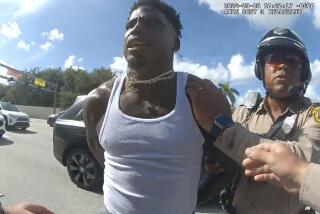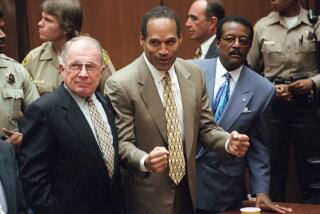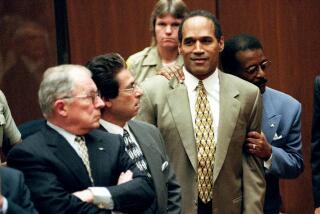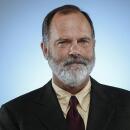Beaten King Was ‘Shown Off’ by 2 Officers, Jury Told : Trial: In dramatic opening day, federal prosecutor says Wind and Powell stopped at Foothill Division station to display their captive on the way to a second hospital.
- Share via
On the opening day of the nation’s most closely watched criminal trial, a federal prosecutor alleged for the first time that two Los Angeles police officers were showing off a battered Rodney G. King at their station when they were supposed to be transporting him from one hospital to another.
During his opening statements to the jury Thursday, Assistant U.S. Atty. Steven D. Clymer said Officer Laurence M. Powell summoned Foothill Division officers outside, where King was sitting with Officer Timothy E. Wind in the back seat of a patrol car.
“He sent police officers out to look at Rodney King while Rodney King was in the back seat, waiting for medical attention,” said Clymer. The prosecutor added that the incident occurred after King had been treated at Pacifica Hospital and was being taken to the jail ward at Los Angeles County-USC Medical Center.
To cover up their two-hour detour to the station, Clymer said, the two officers falsified a report to indicate that they had left Pacifica Hospital at 4:45 a.m. rather than 3:30 a.m., which prosecutors say was the actual time.
“They omit completely on that log that they ever went to Foothill station,” Clymer said.
The prosecutor’s unexpected and explosive disclosure was disputed by one of the defense lawyers in his opening remarks, but it rocked the first day in the trial of four police officers who are charged with violating King’s civil rights on March 3, 1991. Also charged are Sgt. Stacey C. Koon and Officer Theodore J. Briseno. All four defendants face up to 10 years in prison and fines of $250,000 each if convicted.
The 12 jurors and three alternates sat with rapt attention as they heard opening statements from both sides and received their first official exposure to the videotape of the beating, which Ira Salzman, who represents Koon, called “82 seconds that shook our society.”
While the prosecution portrayed King’s beating as a brutal and intentional assault, defense lawyers characterized the officers’ actions as reasonable and necessary to subdue a combative suspect who led them on a high-speed chase and then resisted arrest.
It has been 10 months since a state court jury found the four defendants not guilty on all but one count, and those verdicts ignited three days of rioting in Los Angeles that left 52 people dead. With the threat of riots looming in the background of the federal trial, swarms of journalists from around the world descended Thursday on the federal building where U.S. District Judge John G. Davies has his courtroom.
Security was tight, and journalists and spectators were forced to pass through two metal detectors before they were allowed to enter the courtroom. Inside, reporters and artists took up almost all the seats. Davies, who has ordered that jurors be sequestered for the entire trial and has protected their anonymity, admonished artists not to sketch their faces.
Although Wind’s lawyer did not deliver his opening statement Thursday, Powell’s attorney sharply disputed the prosecution account of the trip the officers allegedly took to the Foothill station. He said the stop was made to expedite King’s booking into a jail hospital ward and argued that the officers did not know at the time that King had any serious injuries.
The doctor who treated King at Pacifica Hospital released him to the officers, said Michael P. Stone, Powell’s lawyer. That doctor’s report did not suggest that King was seriously hurt, he added, since its only notation was that King was treated for “PCP overdose” and “superficial lacerations.”
“They didn’t leave in an ambulance,” Stone added. “They left in a police car.”
The Los Angeles County district attorney’s office, which prosecuted the officers in state court, has made it a policy not to comment on the federal proceedings.
But one county official confirmed that the prosecution team did not know of the stop at the station between the two hospitals. “If we’d had such evidence,” the official said, “we would have presented it.”
In their opening remarks, federal prosecutors and defense lawyers revealed strategies that suggest the federal case will unfold differently than last year’s state trial. Prosecutors listed several new witnesses who did not appear in state court but will be asked to testify this time, and defense lawyers enter the federal case with a newly united front.
During last year’s trial, Briseno split from his colleagues and testified against them. But in his brief opening statement, Briseno’s lawyer, Harland W. Braun, stressed that while the four officers may have had different impressions of the beating, they all were forced to grapple with a difficult suspect during a time of “rising violence against police officers.”
As the case opened, Clymer showed the videotape of the beating first at regular speed and then in slow motion, detailing the blows that form the core of the prosecution’s case. Jurors showed no emotion as the tape played, and by day’s end, they already had seen sections of it half a dozen times.
Clymer told jurors that police are allowed to use force in certain situations, but he said the evidence produced by the federal government would show that the four defendants exceeded their authority.
“This case involves police brutality,” Clymer said. “Each of these defendants was governed by the law and the Constitution of the United States.”
Clymer said medical experts would testify that King was struck repeatedly in the head and face, blows that the prosecutor said violated King’s rights as well as LAPD policy. Sgt. Mark Conta, a use-of-force expert with the LAPD, also will testify and will say that each of the four officers violated Police Department policy, Clymer added.
“The Los Angeles Police Department trains its officers that unless their lives are threatened, they cannot use a baton to strike a suspect in the face or head,” Clymer said.
Defense attorneys, in their opening statements, disputed the contention that King was struck in the head and said their medical experts will show that the head injuries to King--the most serious ones he suffered--were the result of several face-first falls to the pavement.
Stone said King’s facial injuries were inconsistent with baton blows. He told jurors that medical experts would testify to that effect. In a methodical, two-hour opening statement that made use of enhanced versions of the videotaped beating and other video evidence, Stone laid out his case that the officers acted reasonably.
“This incident, far from being an out-of-control beating of a motorist, was a controlled use of force,” Stone said. “In a sense, it is the suspect who is in control.”
In his opening statement, Salzman agreed and said Koon’s behavior throughout the beating was beyond reproach. Koon is not accused of striking King, but he was the ranking officer at the scene and is charged with allowing officers under his supervision to intentionally administer an unreasonable beating.
“We intend to show you that nothing that Sgt. Koon did was illegal, nothing was improper,” Salzman said.
Salzman and Stone denied prosecution claims that their clients filed false police reports, and said they will produce evidence that the officers did their best to represent the incident accurately.
While the day’s biggest shock belonged to prosecutors, defense lawyers revealed a few surprises of their own.
As the federal case at last opened--seven months after the officers were indicted--lawyers on both sides revealed that this trial will be unlike last year’s state prosecution in Simi Valley. Stone, for instance, said he intends to call three witnesses--California Highway Patrol Officers Timothy and Melanie Singer, as well as Bryant Allen, one of the passengers in King’s car.
All three testified for the prosecution in Simi Valley, but discrepancies in their accounts came under fire by defense lawyers. This time, they will testify again, Stone said, but on behalf of the defendants.
“They did so well for us last time, I figured we should call them,” Stone said outside of court.
In addition, Salzman appeared to surprise prosecutors when he announced that one of the witnesses for the defense was the teacher of the prosecution’s chief use-of-force expert.
Prosecutors, meanwhile, told jurors that they will call King and a number of civilian witnesses to the beating, none of whom testified during the state case. Even as the prosecutors acknowledged that King will be a witness in the federal case, they cautioned jurors against passing judgment on him.
Clymer acknowledged that King was drunk on the night of the incident, that he fled from police who tried to pull him over for speeding, that he was slow to obey police commands and that he was on parole for an earlier offense.
But “Rodney King is not on trial,” Clymer said. “The issue of whether he was guilty or innocent that night is not on trial. The issue of whether these four defendants are guilty or innocent is on trial.”
Times staff writer Paul Lieberman contributed to this report.
Key Players in King Trial
With jury selection concluded, opening statements began Thursday in the federal trial of four police officers accused of violating Rodney G. King’s civil rights. Here are some of the main figures in the case. THE JUDGE U.S. District Judge John G. Davies Appointed to the federal bench by President Ronald Reagan in 1986. Notable: Davies is known as a moderate and independent conservative with a wry sense of humor. During the pretrial hearings in this case, he has tried to balance the interests of opposing parties, and he has taken it upon himself to zealously guard the privacy of jurors. Personal: A native of Australia, he won a gold medal for swimming during the 1952 Summer Olympic Games.
THE DEFENDANTS Sgt. Stacey C. Koon Accused of supervising an unreasonable use of force. Notable: Koon has publicly defended the arrest of King and has said that all of the actions by the officers were justified. During the state trial, he took full responsibility for the other officers’ actions. Personal: He recently finished a book on the “Rodney King affair” and has been touring to promote it. Officer Laurence M. Powell Seen on the videotape administering the majority of the blows to King. Notable: Powell was the only defendant during last year’s trial who was not fully exonerated. The jury failed to reach a verdict on one count against him, which will be dismissed because of the federal trial. Personal: Reacting angrily to the accusation that he beat King for racial reasons, he has noted that his family adopted minority children and that he dates a Latina. Officer Timothy E. Wind On the videotape, Wind is seen kicking King several times, as well as hitting him with his baton. Notable: Wind is the only defendant who did not testify during last year’s trial and is the only one to decline all media requests for interviews. Personal: Although he had previously worked as a police officer in Kansas, Wind was an LAPD rookie at the time of the incident and has been dismissed from the force. Officer Theodore J. Briseno Accused of stomping on King’s upper body during the arrest. Notable: Briseno broke ranks with his colleagues during the state trial and testified that the beating was “out of control.” He has since tempered those remarks, and much of his state trial testimony will not be admitted in the federal case. Personal: Like the other defendants, he has been suspended without pay for more than two years. He is now working full time as an assistant to his lawyer. THE PROSECUTORS Barry F. Kowalski Based in Washington, Kowalski was sent here immediately after the riots. Notable: He may be the most experienced civil rights prosecutor in the country. Kowalski has prosecuted Klansmen, neo-Nazis, skinheads and other hatemongers. Steven D. Clymer Considered one of the best prosecutors in the Los Angeles U.S. attorney’s office. Notable: Clymer has served as the head of the major crimes section of the U.S. attorney’s office and has prosecuted a number of high-profile cases. Like Kowalski, he was handpicked to try this case.
THE DEFENSE ATTORNEYS Ira Salzman Represents Koon. Notable: His client is the lead defendant in the federal trial, and Salzman has played the leading role of the defense lawyers in picking the jury. He is a former deputy district attorney but has had his own criminal and civil law practice for about five years. Michael P. Stone Represents Powell. Notable: The most visible of the defense lawyers during last year’s trial in Simi Valley, Stone is a former police officer and onetime representative of the Police Protective League, the Los Angeles police union. Paul DePasquale Represents Wind. Notable: DePasquale served as Wind’s lawyer during the first trial and has consistently kept a lower profile than the other lawyers. His client also has steered clear of the spotlight. Harland W. Braun Represents Briseno. Notable: One of the best-known criminal defense lawyers in Los Angeles, Braun is flamboyant and outspoken. Judge Davies placed a partial gag order on Braun for a time, but that order was overturned last week on appeal.
More to Read
Sign up for Essential California
The most important California stories and recommendations in your inbox every morning.
You may occasionally receive promotional content from the Los Angeles Times.











